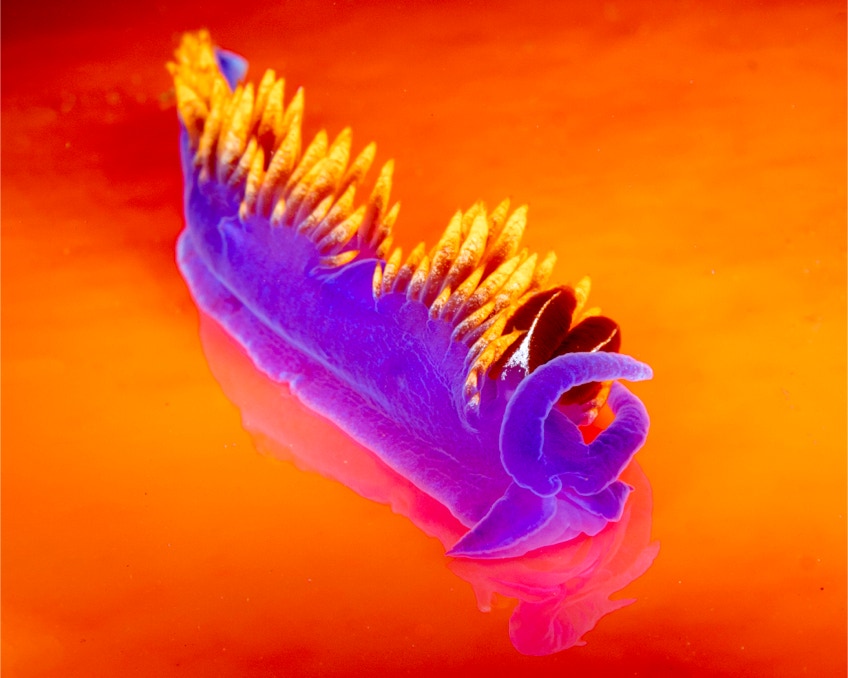August 2020 PODs
Bill’s “Pictures of the Day”
from August 2020

Yet another new stage. After losing a couple of stages, I built a new one; this one with a red/orange dichroic glass. We went diving yesterday with friends on the Giant Stride (cold but good vis) and got to play with the new stage. Here is one of my favorite subjects, the Spanish Shawl sitting on the new stage. Note the subtle reflection.

Saturday it was cold (49-51) and green at the top but clear below with good visibility. Here is an Acanthodoris on the red/orange stage.

The new stage has the red dichroic on one side and a black dichroic (with texture) on the other side. Here is a nice little Hermissenda on the black side from our dive yesterday on the Giant Stride with our friends.

Here is a nice little Rictaxis punctocaelatus or bubble shell (a heterobranch) sitting on a piece of obsidian (thanks Kevin) that we shot last weekend on the Giant Stride. I originally identified it as a snail and was simultaneously corrected by Kevin Lee and Ali H.

Here is a nice little Acanthodoris lutea sitting on the red/orange dichroic stage (without much dichroism). The slug is brightly colored (sometimes called the orange peel nudi). His color is aposematic, telling everyone in the neighborhood that if you try to eat me you will get sick. From last week on the Giant Stride.

Last week I misidentified a heterobranch as a snail. Here is (I think) a real snail from our dive yesterday with friends on the Giant Stride.

Here is a nice little Felimida macfarlandi from our dive on the Giant Stride yesterday. He is sitting on an orange dichroic glass that doesn't seem to be doing much dichroicing (to make up a word).

Here is a nice little Acanthodoris rhodoceras from Garden Spot on last Sunday on the Giant Stride. Here he is sitting on the matte black stage.

Here is a nice little Dendronotus venustus (although Kevin has it as venustes) from our dive on Saturday with friends on the Giant Stride. A central question is why most nudibranchs like it warm but Dendronotus likes it cold; they are mostly found in the arctic and cooler waters. Apparently it arose in the warm Pacific in the pliocene (3-5M years ago) and moved North. Because they were very adaptive to eating unusual foods they were successful in the North and when the Bering sea passage closed and things really cooled off, they stayed in a good example of allopatric speciation. In any case, here he is on a new purple dichroic stage.

D. Venustus again. Here he is on the orange stage.

Here is a nice little Janolus barbarensis (Antiopella now I think) from our recent trip with friends on the Giant Stride. He is sitting on a dichroic stage and the main illumination was a bounce off the stage, hence the blue color cast.

Here is a nice little Acanthadoris rhodoceras this time on the orange dichroic stage.

I am finding that using the red/orange dichroic stage is difficult to figure out. Here is another A. lutea from our dive last week on the Giant Stride with friends. This guy was at Biodome and only one rhinophore ever came out. Tried to shoot this one with the strobe parallel to the stage.

Here is a nice little (not so little) Jorunna pardus
from our most recent trip on the Giant Stride.
There are at least two other species that look very
similar but with different color rhinophores.
Jorunna nudibranchs can make novel chemicals
here called Jorunnamycin. You can see that
Jorunnamycin C is extraordinarily potent (smaller
numbers are better) and might be a good treatment for prostate cancer.

Here is a Felimare porterae on the orange dichroic. He was named (the Porter part) by Cockerell (a name we nudi nerds all know) whose wife’s middle name was Porter. The illustration in the inset is from 1901 (the American Natural History Museum) by MacFarland who must have run out of blue ink.

Here is a nice starburst anemone (Anthopleura sola) from our last dive on the Giant Stride with friends. This guy (you can see why he is called starburst) has some interesting characteristics. If another anemone from a different species comes into his space, he will use his acrorhagi (special stinging tentacles) to sting the invader. The nematocysts will cause the invader's base to become necrotic so he runs away (maybe he just crawls away slowly). If you want to know more about HOW this occurs you can read a paper called The Cellular Basis of the Aggressive Acrorhagial Response of Sea Anemones, but the simple version is that once an intruder is sensed using a series of receptors based on both chemical and mechanical sensing, the acrorhagi extend.
















© 2020-2025 Nannette and Bill Van Antwerp